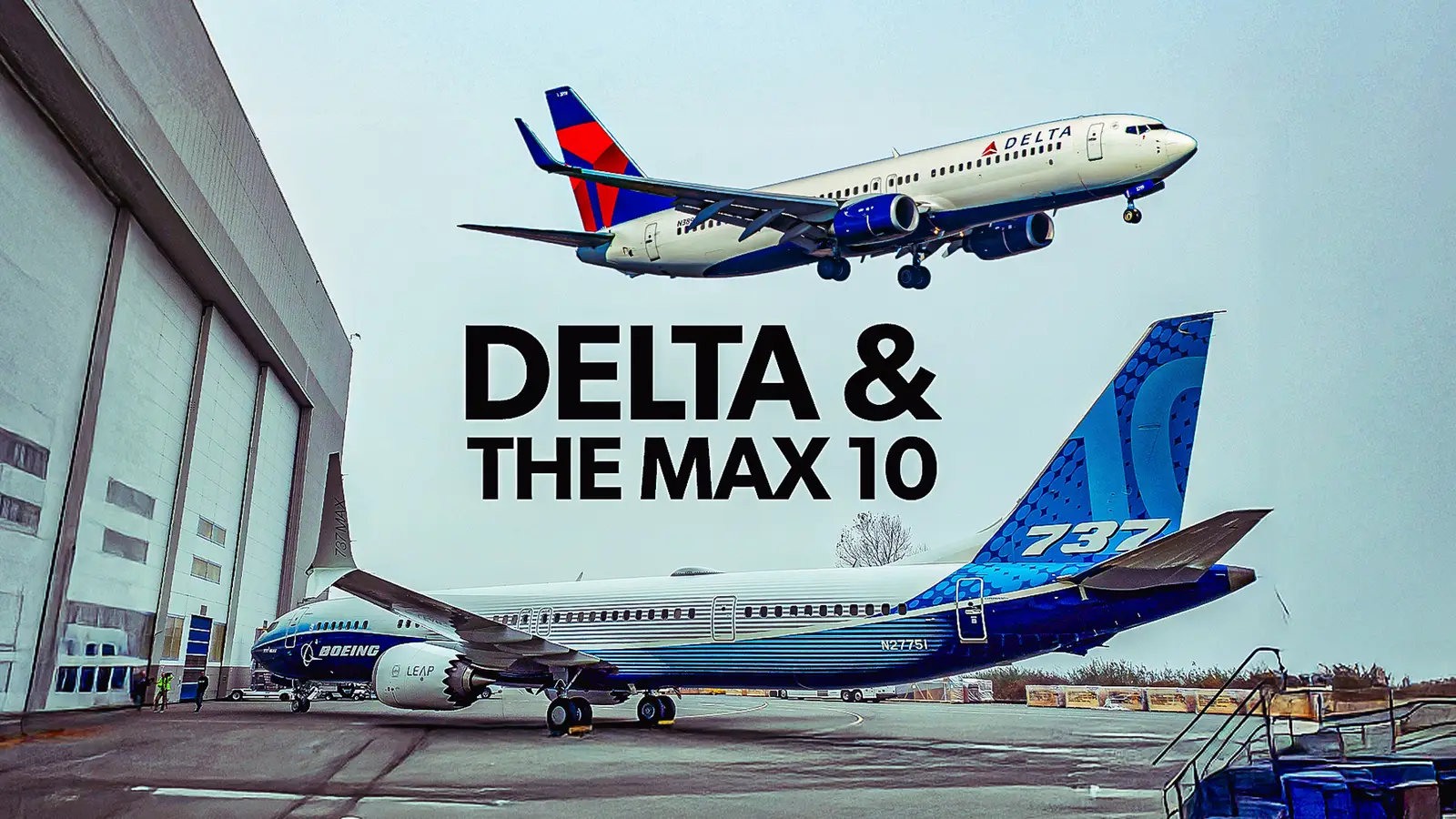
When Delta Air Lines announced its order for 100 Boeing 737 MAX 10 aircraft at the 2022 Farnborough Air Show, the move was seen as a vote of confidence in Boeing’s narrowbody program. The MAX 10 was positioned as a modern, fuel-efficient replacement for aging domestic aircraft, and deliveries were expected to begin in 2025. Three years later, the MAX 10 has yet to be certified, and production is delayed. Despite these challenges, Delta remains publicly committed to the aircraft — for now.
Delta Adjusts Its Expectations
In September 2024, Delta disclosed in a filing with the Securities and Exchange Commission that it had amended its agreement with Boeing. The new delivery schedule pushed the first 20 aircraft into 2026, with the remaining 80 deliveries expected to follow afterward. This aligned with previous comments from CEO Ed Bastian, who said in March 2024 that if the MAX 10 arrived in 2025 at all, it would likely be “late in the year” — and added it could be “another year or two beyond that.”
As of mid-2025, Delta has not publicly changed or canceled its MAX 10 order. In a June 2024 interview reported by Reuters, Bastian stated, “I’m confident we will see improvement,” and that Delta was “committed” to the Boeing MAX 10, even as the airline acknowledged that it would not receive the aircraft anytime soon.
A Delayed Certification Timeline
The MAX 10 still lacks certification from the Federal Aviation Administration. According to a July 2025 report by The Air Current, both the MAX 7 and MAX 10 are now expected to be certified in 2026 at the earliest. The cause of the delay is a still-unresolved problem with the aircraft’s engine anti-ice system. Boeing’s initial proposed fix introduced new concerns, which prompted further redesign work. The report stated, “We are maturing a technical solution that includes design updates … The modifications would be included in the baseline of the certification of the 737-7 and 737-10. We are finalizing our analysis and will present the information to the FAA. We will continue to work under their rigorous oversight to meet safety and regulatory requirements.”
This system flaw is significant. In 2023, the FAA warned that using the anti-ice system for more than five minutes in dry air could cause the engine inlets to overheat and separate. This poses a risk of debris striking the aircraft windows and potentially leading to cabin decompression. While MAX 8 and MAX 9 aircraft continue to fly with operational limitations, the MAX 7 and 10 remain grounded until the issue is fully resolved.
Production Challenges Continue
While Boeing had planned to begin MAX 10 production in Everett, Washington, in 2024, the timeline has been repeatedly delayed. At a July 2025 earnings call, Boeing CEO Kelly Ortberg confirmed that production would now begin after FAA certification is secured, expected in 2026. According to reporting by HeraldNet, Ortberg said the fix was taking longer than expected, “We went through some testing, and this is a very delicate area that we’re dealing with around the inlet of the engines, and it can cause any perturbation to the airflow into the engines.”
Ortberg also stated, “The engineering design did not yield in the time frame that we were anticipating, and so we still have work to do.”
The Everett production line was chosen in part due to available space following Boeing’s move of 787 production to South Carolina and the end of 747 production in 2022. The facility, the largest by volume in the world, still employs more than 30,000 people and now plays a new role in Boeing’s single-aisle strategy.
According to Ortberg, the MAX 10 differs significantly from other variants in the family, requiring longer production time. “So it will naturally flow through the factory at a slower pace,” he said, adding, “So by isolating or providing that fourth line in Everett, it will allow us to let the three lines in Renton flow faster.”
The Everett production line will be slower than Renton’s, partly because the MAX 10 is significantly longer than earlier variants. Boeing has also been restricted by an FAA-imposed cap of 38 MAX aircraft per month. That cap was instituted after a January 2024 incident in which a door plug blew off a MAX 9 mid-flight, prompting investigations and renewed regulatory scrutiny. Ortberg said Boeing plans to ask the FAA to increase the monthly cap to 42 aircraft. Certification of the MAX 10 alone will not be enough — the FAA must approve any rate changes.
These steps are unfolding as Boeing works to recover from years of setbacks, including a machinists’ strike and lingering reputational damage from the crashes that grounded the MAX fleet between 2019 and 2020.
A Strategic Fit For Delta
Despite these setbacks, the MAX 10 still fits a critical role in Delta’s long-term fleet strategy. The aircraft is designed to seat up to 230 passengers and offers better fuel economy than the 737-900ERs and older 757s it is intended to replace. When Delta announced the order in 2022, the airline emphasized the aircraft’s environmental performance and cabin enhancements, including seatback screens, high-speed Wi-Fi, and upgraded lighting.
The MAX 10 was also intended to compete directly with the Airbus A321neo — an aircraft that Delta already operates in growing numbers. Delta’s MAX order was its first Boeing narrowbody purchase in over a decade, signaling a more balanced fleet strategy moving forward.
Industry Comparison: United vs. Delta
While Delta has remained patient, other airlines have made more aggressive adjustments. United Airlines, once expected to be the MAX 10 launch customer, has significantly scaled back its expectations. In early 2024, United CEO Scott Kirby reportedly advised Boeing to stop building the MAX 10 and reallocate production to the MAX 9. United also began converting some MAX 10 orders to Airbus A321neos, according to Simple Flying.
Delta, in contrast, has not taken similar steps. No reports or filings indicate a shift to Airbus narrowbodies in response to MAX 10 delays, nor have any orders been deferred or canceled publicly.
Regulatory Pressures And FAA Oversight
Since the MAX grounding in 2019 and subsequent congressional inquiries, the FAA has increased its oversight of Boeing’s manufacturing and certification processes. The agency has moved away from allowing Boeing to self-certify key systems and now imposes more rigorous testing and documentation requirements.
For the MAX 10, this stricter regulatory environment has slowed progress but is widely seen as necessary to rebuild public trust. The FAA has also made clear that lifting the 38-aircraft-per-month production cap will depend on Boeing demonstrating sustained compliance with quality standards.
Financial Stakes And Future Outlook
Boeing’s financial future depends heavily on the success of the MAX program. As of mid-2025, the company has more than 4,500 unfilled orders for the MAX family. According to HeraldNet, Boeing reported a $612 million loss in Q2 2025, despite a 35% year-over-year increase in revenue. The company brought in $22.7 billion in revenue during the quarter, and executives said they expect to reach $3 billion in free cash flow by the end of 2025 as they work through the MAX backlog. Analysts expect that Boeing could generate as much as $10 billion in free cash flow annually by 2028 — but only if it can stabilize production and deliver aircraft on time. That level of recovery, however, depends on ramping up output to at least 47 jets per month, a figure the company has not yet reached.
Delta’s order is a significant part of that picture. The airline’s continued patience lends credibility to Boeing’s recovery efforts, but that goodwill is not unlimited. If Boeing fails to meet its revised certification and delivery timeline, it could jeopardize not just individual deals but long-term customer confidence across the industry. If certification delays stretch into 2027 or new safety issues emerge, Delta may be forced to reassess its options.
Alternatives If Delays Persist
So far, Delta has not publicly discussed alternatives to the MAX 10, but the airline has options. It already operates a growing fleet of Airbus A321neos and could expand that order book. It could also opt to extend the life of its existing 737-900ERs and 757s through maintenance and interior upgrades, though these would only provide a short-term solution.
Switching orders would not be without challenges. Delivery slots for Airbus aircraft are limited, and pricing negotiations would be complex. But United’s pivot shows that such shifts are possible under prolonged uncertainty.
Conclusion
As of September 2025, Delta Air Lines remains committed to the Boeing 737 MAX 10 — at least publicly. The aircraft still fits the airline’s operational goals and fleet plan, and Delta appears to be betting that Boeing will resolve its technical and regulatory hurdles within a reasonable timeframe.
But the clock is ticking. The MAX 10 is already years behind schedule, and Boeing’s credibility with regulators and the flying public remains fragile. If delays continue into 2027 or beyond, Delta’s patience may begin to waver.
For now, Delta is still interested. But that interest, like the aircraft itself, comes with built-in limits.



